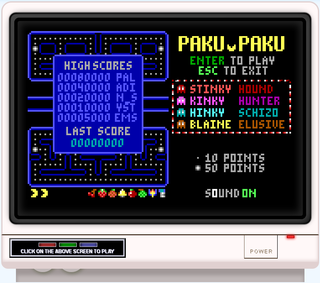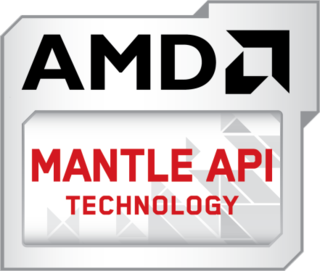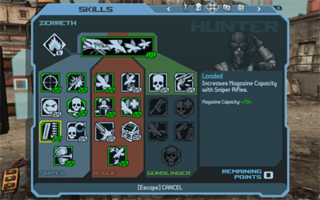
Microsoft DirectX is a collection of application programming interfaces (APIs) for handling tasks related to multimedia, especially game programming and video, on Microsoft platforms. Originally, the names of these APIs all began with "Direct", such as Direct3D, DirectDraw, DirectMusic, DirectPlay, DirectSound, and so forth. The name DirectX was coined as a shorthand term for all of these APIs and soon became the name of the collection. When Microsoft later set out to develop a gaming console, the X was used as the basis of the name Xbox to indicate that the console was based on DirectX technology. The X initial has been carried forward in the naming of APIs designed for the Xbox such as XInput and the Cross-platform Audio Creation Tool (XACT), while the DirectX pattern has been continued for Windows APIs such as Direct2D and DirectWrite.
A game engine is a software framework primarily designed for the development of video games and generally includes relevant libraries and support programs such as a level editor. The "engine" terminology is akin to the term "software engine" used more widely in the software industry.

OpenAL is a cross-platform audio application programming interface (API). It is designed for efficient rendering of multichannel three-dimensional positional audio. Its API style and conventions deliberately resemble those of OpenGL. OpenAL is an environmental 3D audio library, which can add realism to a game by simulating attenuation, the Doppler effect, and material densities.

CryEngine is a game engine designed by the German game developer Crytek. It has been used in all of their titles with the initial version being used in Far Cry, and continues to be updated to support new consoles and hardware for their games. It has also been used for many third-party games under Crytek's licensing scheme, including Sniper: Ghost Warrior 2 and SNOW. Warhorse Studios uses a modified version of the engine for their medieval RPG Kingdom Come: Deliverance. Ubisoft maintains an in-house, heavily modified version of CryEngine from the original Far Cry called the Dunia Engine, which is used in their later iterations of the Far Cry series.

A personal computer game, also known as a computer game or abbreviated PC game, is a video game played on a personal computer (PC).
A physics processing unit (PPU) is a dedicated microprocessor designed to handle the calculations of physics, especially in the physics engine of video games. It is an example of hardware acceleration.

PhysX is an open-source realtime physics engine middleware SDK developed by Nvidia as a part of Nvidia GameWorks software suite.

Telekinesys Research Limited (TR), doing business as Havok Group, is an Irish software company founded on 9 July 1998 by Hugh Reynolds and Steven Collins, based in Dublin, Ireland, and owned by Microsoft's Ireland Research subsidiary. They have partnerships with Activision, Electronic Arts, Nintendo, Xbox Game Studios, Sony Interactive Entertainment, Bethesda Softworks and Ubisoft.
Wwise is Audiokinetic's software for interactive media and video games, available for free to non-commercial users and under license for commercial video game developers. It features an audio authoring tool and a cross-platform sound engine.
Panda3D is a game engine that includes graphics, audio, I/O, collision detection, and other abilities relevant to the creation of 3D games. Panda3D is free, open-source software under the revised BSD license.
HeroEngine is a 3D game engine and server technology platform originally developed by Simutronics Corporation specifically for building MMO-style games. At first developed for the company's own game Hero's Journey, the engine won multiple awards at tradeshows, and has since been licensed by other companies such as BioWare Austin.
RakNet is networking middleware developed by Oculus VR, Inc. for use in the video game industry. RakNet was originally authored by Jenkins Software LLC.
Fork Particle is a computer graphics visual effects modeling and software development kit (SDK) developed and sold by Fork Particle, Inc. Fork Particle uses its real time particle system technology to simulate visual effects or particle effects such as CGI explosions, fire, rain, smoke, dust, etc. Fork Particle is used in video games and visual simulation software such as a flight simulator. It has been licensed to game developers for Windows, macOS, Linux, PlayStation 3, PlayStation 4, Xbox 360 and Xbox One.
Dovetail Games (DTG), a trading name of RailSimulator.com Ltd (RSC), is a British simulation video game developer and publisher established in 2008 by former Electronic Arts executive Paul Jackson, Fund4Games backers Tim Gatland and Charlie McMicking, and a development team from Kuju Entertainment.

Mantle was a low-overhead rendering API targeted at 3D video games. AMD originally developed Mantle in cooperation with DICE, starting in 2013. Mantle was designed as an alternative to Direct3D and OpenGL, primarily for use on personal computers, although Mantle supports the GPUs present in the PlayStation 4 and in the Xbox One. In 2015, Mantle's public development was suspended and in 2019 completely discontinued, as DirectX 12 and the Mantle-derived Vulkan rose in popularity.
Autodesk Gameware is a discontinued middleware software suite developed by Autodesk. The suite contained tools that enable designers to create game lighting, character animation, low level path finding, high-level AI and advanced user interfaces. On July 12, 2017, Autodesk removed Scaleform, Beast, HumanIK, and Navigation from their online store, and announced the ending of support for the products.

TrueAudio is AMD's application-specific integrated circuit (ASIC) intended to serve as dedicated co-processor for the calculations of computationally expensive advanced audio signal processing, such as convolution reverberation effects and 3D audio effects. TrueAudio is integrated into some of the AMD GPUs and APUs available since 2013.

Scaleform GFx is a discontinued game development middleware package, a vector graphics rendering engine used to display Adobe Flash-based user interfaces and HUDs for video games. In March 2011, Autodesk acquired Scaleform Corporation and Scaleform GFx became part of the Autodesk Gameware line of middleware. On July 12, 2018, Autodesk discontinued Scaleform GFx, and it is no longer available for purchase.

RenderDoc is a free and open source frame debugger that can be used to analyze single frames generated by other software programs such as games. RenderDoc can provide in-depth analysis of single frames from any application that uses Vulkan, D3D11, OpenGL & OpenGL ES, or D3D12. RenderDoc also allows the user to manipulate a captured frame to inspect different things such as pipeline stage, commands, texture maps, models, assets, and more. RenderDoc can also capture assets outside the view of the game's camera. RenderDoc supports analyzing frame rendering costs on the graphics processing unit.









